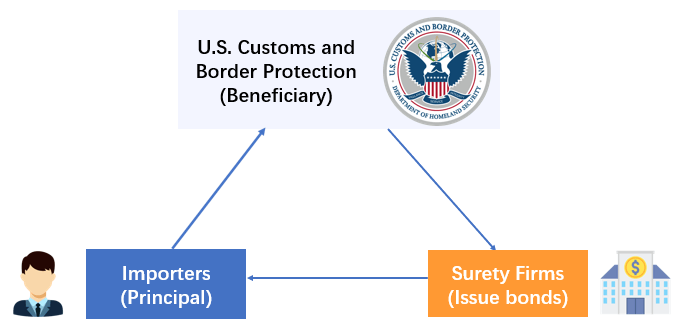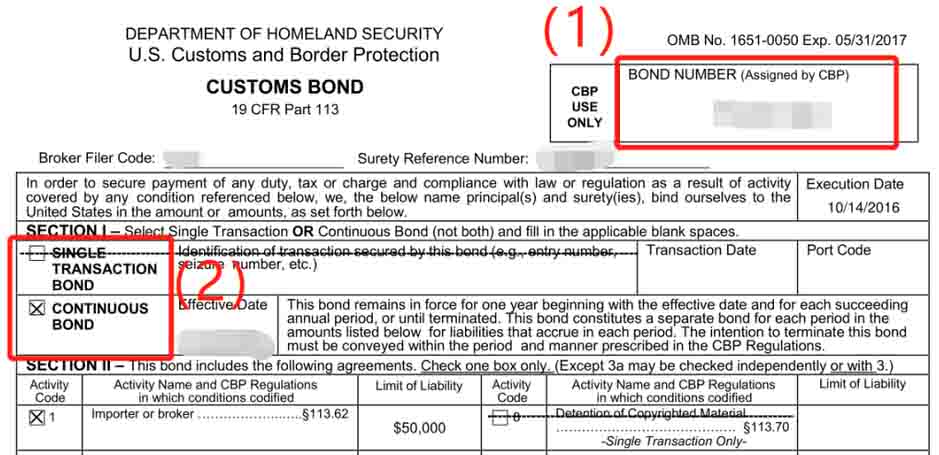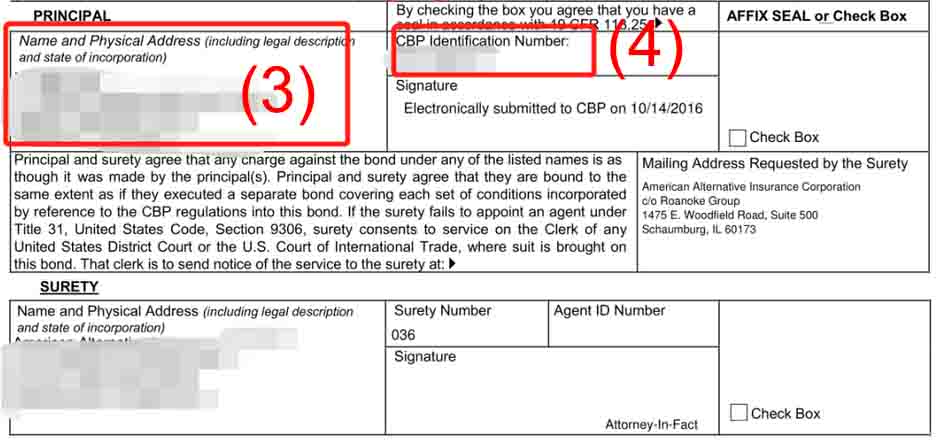When importing from China to the USA, it is necessary to buy bonds for US import customs clearance. In today’s post, I explain customs bonds from the following 7 points that are highly concerned by importers.
1. What is a customs bond?
Customs bonds are mandatory for you when importing goods into the USA. Simply put, the customs bond is an assurance involving 3 parties: U.S. CBP (Customs and Border Protection), importers, and surety firms. The beneficiary is US customs plus the government. Customs bonds guarantee that importers will comply with all customs regulations and fulfill financial responsibilities for customs duties, taxes, and fines.

In case importers can’t pick up goods for some objective reason like bankruptcy, without payment for duties, storage fees, and other expenses. Once that happens, CBP will collect the payment, up to the bond amount, from the surety firm that issues the bond. And the bond issuer will take legal means to collect from importers.
How do customs bonds work?
The surety company pays CBP first and CPB releases your goods. As an importer, you just need to give the money back to the company later.
In this way, CBP is able to clear the shipment covered by the bond, without an additional wait for the importer to pay. This means a shorter time for customs clearance and is good for your import business.
Once your shipment fees exceed the purchased bond value, the surety firm will ask you to buy a large-size bond. And only after the new bond is posted will Customs release the goods that meet regulatory requirements.
2. When is a customs bond required?
As required by CBP, all individual importers or registered companies must file a customs bond as long as the products are:
- valued at $2,500 or more and for commercial purposes, including even duty-free items.
- subject to other federal agencies’ requirements, such as firearms and food.
When your import meets the above 2 situations, you need to buy a bond to clear customs. If not, your goods will be rejected by customs, because they are not on file with U.S. Customs. Even if you have already made an ISF declaration, you still can’t clear the shipment. In the meantime, you’ll receive punishments from customs and pay fines.
That is to say, the bond is a compulsory ticket for your cargo to enter the US. And you have to finish the purchase of bonds 4 days before your vessel sets sail at the port of departure.
3. What are the most common types of customs bonds?
According to users and specific activities, there are many different customs bond types, such as import bonds, foreign trade zone operator bonds, international carrier bonds, drawback bonds, custodian bonds, and so forth.
For importers, the most common customs bonds are the following 2 types.
1. Annual Bond or Continuous Bond (CB)
As the name suggests, this bond type only needs the purchase once a year. If you import products many times or your shipment is valued high, you can buy the annual bond under your own company’s name and use it to clear multiple shipments. Even if you change customs brokers, your annual bond is still valid.
Since the bond is issued, it is valid for one year, except for the cancelation by the importer or the surety. Continuous bonds can be set to renew automatically. If renewed by manual methods, it should be 2 months before the bond is due. In the bond renewal process, importers and the surety company can make changes if necessary.
One more thing, an annual bond covers ISF regulations when shipping goods by sea.
2. Single-entry Bond or Single Transaction Bond (STB)
Also known as the single bond, STB is designed for a batch of shipment. It is only valid for one time and can’t be renewed. This bond type is suitable for buyers who import once or twice every year and the shipment value is not high. Most bond providers, i.e., surety firms, issue STBs three times at most per year. If exceeding that, it easily leads to the CBP check.
4. What bond amount do you need?
The bond amount or size relates to the product type, shipment value, duties, taxes, and the types of bonds you buy.
Annual bonds cover regulated goods, but anti-dumping products are not included. The amount of this bond type is usually 10% of your duties, taxes, and fees during the previous 12 months. The formula is as follows.
Annual bond amount = 10% * (total annual duties + taxes + fees)
Note there is a minimum bond amount of $50k. If your annual duties and taxes are $450k, you need to buy a $50k bond. Once your annual duties and taxes have reached or exceeded the benchmark of $500k, you need a larger bond amount than $50k.
Referring to the following calculation table, you first look at which range your annual duties and taxes are located, and then find the required bond amount.
| Total Duties & Taxes (past 12 monthes) | Bond Amount |
|---|---|
| $0-$500,000 | $50,000 |
| $500,000-$600,000 | $60,000 |
| $600,000-$700,000 | $70,000 |
| $700,000-$800,000 | $80,000 |
| $800,000-$900,000 | $90,000 |
| $900,000-$1,000,000 | $100,000 |
| $1,000,000-$2,000,000 | $200,000 |
| $2,000,000-$3,000,000 | $300,000 |
| $3,000,000-$4,000,000 | $400,000 |
| $4,000,000-$5,000,000 | $500,000 |
| $5,000,000-$6,000,000 | $600,000 |
| $6,000,000-$7,000,000 | $700,000 |
| $7,000,000-$8,000,000 | $800,000 |
| $8,000,000-$9,000,000 | $900,000 |
| $9,000,000-$10,000,000 | $1,000,000 |
Suppose your total duties and taxes last year were $550k, you need to round it up to the next $100K, i.e., $600k. Then, obtain the bond amount you need — 10% * $600k = $60K.
If your total duties and taxes last year were $1,550k, you need to round it up to the next $1,000K, i.e., $2,000k. Then, obtain the bond amount you need — 10% * $2,000k = $200K.
For single-entry bonds, the bond amount is calculated based on the individual shipment value, plus any duties, taxes, and fees. You can use the formula below for calculation.
Single-entry bond amount = individual shipment value + duties + taxes
Note the amount of this bond type must not be less than $100, except when the law or regulation expressly provides that a lesser amount may be taken.
The above-mentioned is applicable to goods without the supervision of other U.S. government agencies. If subject to other US regulatory authorities, the bond amount should be 3 times the value of your goods. Suppose you import food products under FDA supervision and the freight value is $30k, you need to buy a $90k bond (3*$30k).
5. How to get a customs bond?
As an importer, you can’t purchase the bond by yourself. It is a must to find authorized agents to do that, who can be:
- surety companies licensed by the U.S Treasury Department
- local customs broker or international freight forwarder.
The latter is the easiest way. All you need to do are the following 3 steps.
Step 1 — Find a suitable freight or customs broker.
The bond can be purchased in the name of your own company or freight/customs brokers.
Note the customs clearance goes in the name of the one buying customs bonds. And he is also responsible for associated issues during the entire clearance process.
If you don’t have the qualification or don’t want to use your company’s name to clear goods, you can use your freight forwarder or customs broker title.
If you import kids’ toys subject to CPSC supervision, using the freight brokers’ title is not feasible. Because US customs won’t accept the forwarder’s identity for imports. In such cases, you need to get a bond through a local customs broker to prove that you have the qualification to import such goods. For a list of licensed customs brokers, check the port of entry.
Step 2 — Fill out relevant documents and provide tax ID No.
You need to complete the CBP Form 301, POA (Power Of Attorney), and relevant documents. About POA, your customs broker will provide it and you just sign it. This means you authorize him to file import entries on your behalf.
About CBP Form 301, you can fill out the form under your broker’s guidance. Only one scanned copy is required. Here I share an annual bond CBP Form 301 example for your reference.
As for the 4 red-marked areas, I explain them further.
- The first defines the bond number assigned by CBP. It is unique.
- The second means you have to choose the bond type. The small box on the right side is the bond effective date.
- The third is specific info on the U.S. import customs clearance subject, usually importers.
- The fourth is the importer’s tax ID/EIN number.
Step 3 — Get a customs bond from your broker.
Your broker will submit proper importing paperwork, complete the online eBond application, and follow up on the process. Once receiving CBP’s approval, the broker will issue a bond to you. One more thing, you’ll get a customs bond within 1-4 workdays when cooperating with experienced customs brokers.
Jingsourcing supports your import business with long-term reliable forwarders who cooperate with experienced local customs brokers.
6. How much does a customs bond cost?
Customs bond purchase fees mainly lie in the cost to buy the broker’s title for clearance.
If you buy single bonds, the bond fee is calculated on the individual shipment value at a rate of five per thousand. The rate varies among different brokers. In addition, the higher the shipment value, the higher the bond fees. For supervised products, calculate the bond fee by shipment value*3*charged rate.
For annual bonds, customs brokers generally charge you from $500 to $1000.
Professional customs agencies usually buy annual bonds for different product categories, for example, consumer electronics. This makes goods cleared at customs efficiently. Such additional costs are worth it.
Three further asked questions
Why do I need a customs bond?
When importing goods worth $2,500 or more into the US for business, you need a customs bond. This is a requirement enforced by the US CBP to ensure that all required duties and taxes are properly paid. Without this bond, your goods will not be released by customs.
What is a customs bond number?
The bond number is assigned by CBP. It is unique and should be filled in the CBP Form 301.
Do customs bonds expire?
A single bond is a one-time use guarantee and cannot be renewed. An annual bond, on the other hand, remains valid for one year from the date of issuance. You can check your customs bond status via the CBP ACE portal and apply for renewal two months before it expires.
The end
Believe you get a better understanding of customs bonds and know how to get the right one. Should you have any questions, leave a comment below.
As a leading Chinese sourcing agent, Jingsourcing has helped many clients import products from China, from product selection to customs clearance and delivery to the door. More than half of our clients are located in the USA. More importantly, we have long-term reliable forwarders who cooperate with licensed customs brokers in the USA to smooth the clearance process. Contact us to support your import business.



Leave A Comment